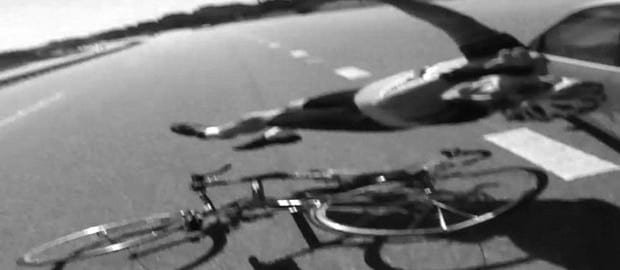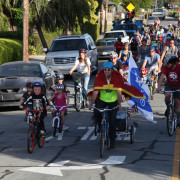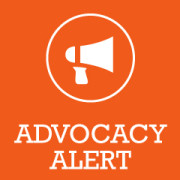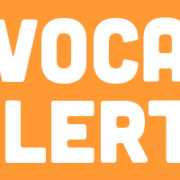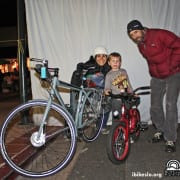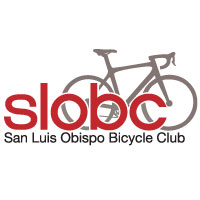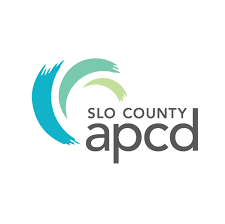Preventing Collisions by Addressing Distracted Driving
With summer fast approaching and more bicycle riders than ever on our roadways, we have been hearing of multiple avoidable collisions between bicycle riders and motorists. In response to a personal experience one of our members wrote an incredible letter to the editor in this week’s Tribune.
We’d like to take this opportunity to thank Lea for letting us publish it here and wish a speedy recovery for anyone who has been in an crash recently. If you or someone you know has been in a crash, the Bicycle Coalition has resources available for you to assist in asserting your rights on a bicycle. Contact us at crash@slobikelane.org.
The following originally appeared in the May 22, 2013 issue of the SLO Tribune.
Plea from an injured cyclist’s wife: Drivers, pay attention
By Lea Brooks
Anxiously waiting outside the emergency room at Sierra Vista Regional Medical Center in San Luis Obispo, I tried not to speculate about my husband’s injuries. All I knew is that he had been hit by a car while bicycling on Highway 1 in Morro Bay and that the trauma team was still evaluating the damage.
California Highway Patrol Officer C.L. Hawkins, who was investigating the crash, emerged from the trauma center’s closed doors carrying a black plastic garbage bag containing the tattered clothes and other belongings of my husband, Myron “Skip” Amerine. She also handed me his cracked, blood-stained helmet.
The driver, she said, was a 23-year-old woman from Cayucos who was running late to her job in Morro Bay. The driver didn’t see Skip until she collided with him from behind at approximately 65 mph. Officer Hawkins said the driver told her she “must not have been paying good enough attention” — a statement included in the official CHP traffic collision report.
The crash occurred on the tricky southbound stretch of Highway 1 between the Highway 41 onramp and Main Street onramp. Bike riders are supposed to follow the dashed white line to the right of the through slow lane and avoid weaving across the on- and off-ramps.
An image captured by Myron ‘Skip’ Amerine’s helmet camera as he was struck by a car.
A digital video camera image of Skip and his bicycle flying horizontally over the dashed white line where he was supposed to be riding provided solid evidence the driver was at fault. The camera had been mounted on his helmet, but popped off on impact and kept recording until it was turned off by the investigating officers.
The video image is a chilling reminder of the risks people who ride bikes, pedestrians and other motorists face from distracted drivers. An appalling number of drivers are texting, talking on the phone, impaired by alcohol or drugs, or generally not paying attention while behind the wheel of a moving vehicle.
The driver was cited for violation of California Vehicle Code 21658(a), which states a vehicle shall be driven as nearly as practical entirely within a single lane and shall not be moved from the lane until such movement can be made with reasonable safety.
Skip’s injuries included a concussion, compound fracture of a lower vertebra and nasty bruises and abrasions from head to foot. I’m relieved he wasn’t killed or more seriously hurt, but am angry he was the victim of a crash that was 100 percent preventable. Distracted drivers need to realize the consequences of their actions.
In Skip’s situation, he faces weeks of painful healing and reliance on me and others for assistance with daily living. His activities will be hampered by a back brace for two months. Resumption of daily bicycle rides is a distant goal. Our plans for the rest of the year, including a bicycle tour, have been cast aside to focus on Skip’s recovery.
What a paradox that the crash occurred on May 1, the first day of Bike Month. This local and national celebration encourages people to bicycle to work, school, to run errands and for fun and exercise. As bicycle advocates for many years, Skip and I support Bike Month’s role in motivating people to try cycling, and were looking forward to participating in the myriad activities scheduled in San Luis Obispo.
So, how do you encourage people to bicycle when you are the victim of a distracted driver? Many people don’t ride because they are afraid of being hit by a motorist, especially from behind. While statistics show rear-end collisions are not common, they do happen.
My response is that there is risk in almost everything we do, including driving a car. The risk of bicycling is more than offset by its health benefits. Other benefits include reducing greenhouse gases that contribute to global warming, relieving traffic congestion, no gasoline or parking expenses and saving time by combining exercise and transportation. Plus, bicycling is downright fun.
Bike Month provides a platform to remind bike riders about steps they can take to improve their safety, including wearing a helmet and brightly colored clothing, signaling turns and obeying traffic signals and other rules of the road. For more information about bicycle safety and gaining confidence to ride in traffic, enroll in a bicycle education workshop offered by the San Luis Obispo County Bicycle Coalition at slobikeed.org. Joining the Bicycle Coalition by going to slobikelane.org is a constructive way to support efforts to improve the quality of life on the Central Coast through bicycling advocacy, education and inspiration.
Bike Month activities are posted on the San Luis Obispo Council of Governments’ website at rideshare.org/bikemonth2013. It’s not too late to dust off that bike in the garage and participate.
My plea to motorists: Pay attention! Put down that smartphone and other devices, avoid distractions and be alert for people who ride bikes on the road, especially before opening your car door or in blind spots before entering or leaving a lane of traffic. Bicycles are a legitimate form of transportation and cyclists deserve your respect. And remember that distracted driving crashes are preventable.
Lea Brooks is a journalism graduate of Cal Poly. She recently returned to San Luis Obispo after living and working in Northern California for 30 years. She and her husband have been active in bicycle advocacy and advisory groups.

